A Wartime Farm near RAF Hawkinge
'Unceasing Endeavours' - Detailed Meaning From a Battle of Britain Painting (Part 2)
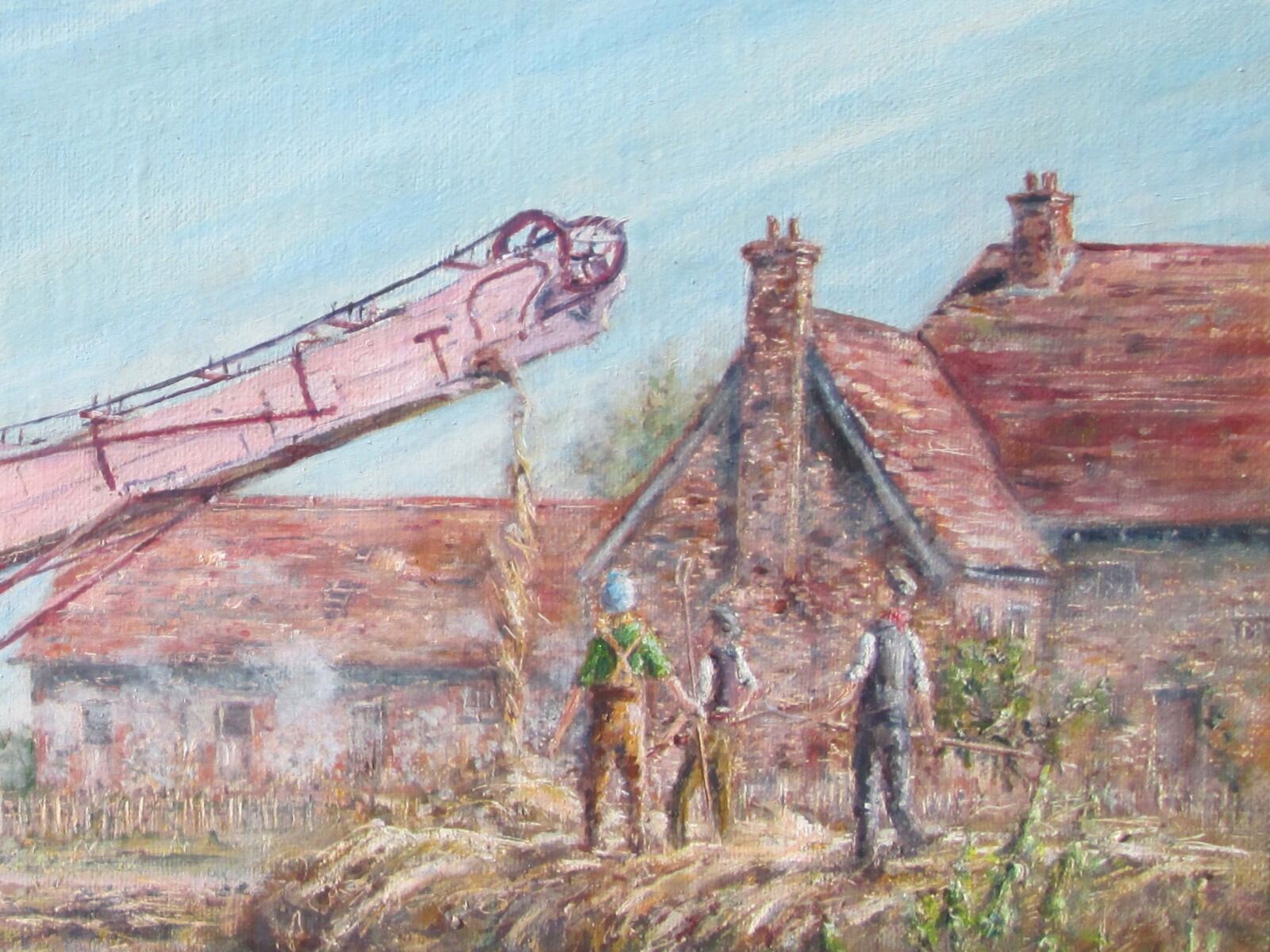

Getting heavily stuck into painting the detail in my artworks is maybe ‘a thing’ for me. But there is reason for that, and perhaps never more so than here in ‘Unceasing Endeavours’, my painting of three Spitfires of 610 Squadron roaring fast and low over a farming scene on their way to another intercept of the German Luftwaffe at the height of the Battle of Britain…
On the face of it, it’s an ‘aviation painting’, and so in that regard, many might have felt that a briefer treatment of the scene on the ground would have been entirely adequate to ‘set the scene’ of the action overhead.
But what if the genesis of the painting was in fact there amidst all that ‘scene setting’ farming activity? Even almost lost in the background of it? Because that is where the story of this painting actually started for me… in that rather ancient looking old clay brick and tile farmhouse, and even though that was the original ‘anchor’ for the piece… it’s not a real farmhouse either… perhaps I’d better explain!
It was the excellent book, ‘Eagle Day’, by Richard Collier, that set this all in motion. His account of a small part of the Battle of Britain weaves together stories from both sides of the conflict with stories from civilians living around and amongst it too, on both sides of the Channel. In doing so, he creates a startling picture of this brief, but oh so significant, moment in historical time, and thereby throws one’s sensibility to the moment into something of the perspective of those that lived through it.
Whilst many of us today still appreciate the importance of the Battle in determining the eventual outcome of the war, those that lived at the moment coped not only with the trials imposed by its happening, but also with a deep sense of ‘not knowing’ about how things would turn out... something like the ‘what ifs’ of our everyday lives, magnified a thousand time in significance perhaps.
Nowhere did the sense of this strike me more than in one of the tales woven through the book; a tale following the fate of a 40 year old farmer and family man, Robert Bailey. His farm, ‘Ladwood Farm’, stood within two miles of RAF Hawkinge in Kent, and only a few miles from the coast.
Not only was the nearby presence of one of the frontline Fighter Command airfields something that suddenly had a whole new significance for him, but there was also the fact of being only a few miles from the Kent coast, which carried the very real risk of being full of German soldiers any day soon.
It is not for me to retell Bailey’s story here, but in reading it, we live through his decision to stay put and keep farming, whilst many in the local area moved away in the face of the immense perceived risk. This is swiftly followed by the need to divert activity from the pressing daily needs of the farm to dig a decent air raid shelter for the family. Perhaps the most striking moment for me, was living vicariously through his witnessing a Hurricane pilot baling out, then watching as the abandoned stricken aircraft soared mindlessly towards the farmhouse occupied at that moment by the whole of his family, only for it to veer away in a slight quiver of wind, the relief of this heavily tempered by its new ‘aim’ being directly at his entire herd of cattle all huddled up together in a field corner…
It is only right to share here that the incident ended relatively benignly, the Hurricane clipping a tree branch at the last moment and swerving into the farm’s woodland, but the fear in the moment was palpable and real.
It was reading of this incident especially that set this painting in motion for me, for it brought home just how closely the fates of those living and working under the battle woven skies in South East England in 1940 were bound up with their compatriots in the air. Not only was the vital food they were producing key to the country’s survival, but the drama of the combat played out above them was highly tangible and, even if not to the same extent as faced by those airmen above, risks to life and limb were ever present too.
As it was this story of Bailey’s that had brought the idea of the painting into being, my first thought had been to try and paint a scene with Ladwood Farm, or one of the other specific farms close to Hawkinge. The idea being to tie together in the painting the interlinked nature of the life on the ground and in the air at this strange moment in time. After some research, I decided that the idea of trying to show a specific farm there as it was in 1940 would take an unfeasible level of research to portray honestly.
It was in the scope of the same set of thoughts though, that I realised that perhaps the abstraction of painting a fictionalised farm which could in many ways represent Bailey’s experience and others whose experiences must have been similar, would be entirely appropriate. As a painting direction to go in, it seemed a good one, given my interest in vernacular farm buildings and fascination with, and involvement in, historical farm practices. This would allow me a lot more freedom of composition to express the core idea of the painting.
And so the quaint little farm of the painting was born, with its long interesting roofs, bold chimneys and funny mix of curious sized little leaded windows. Adjoined to this is a small entourage of farm buildings added to it over the previous hundred or so years, together with one of those notable signs of the wilting fortunes of 1930s depression era farming, the hole ridden roofs.
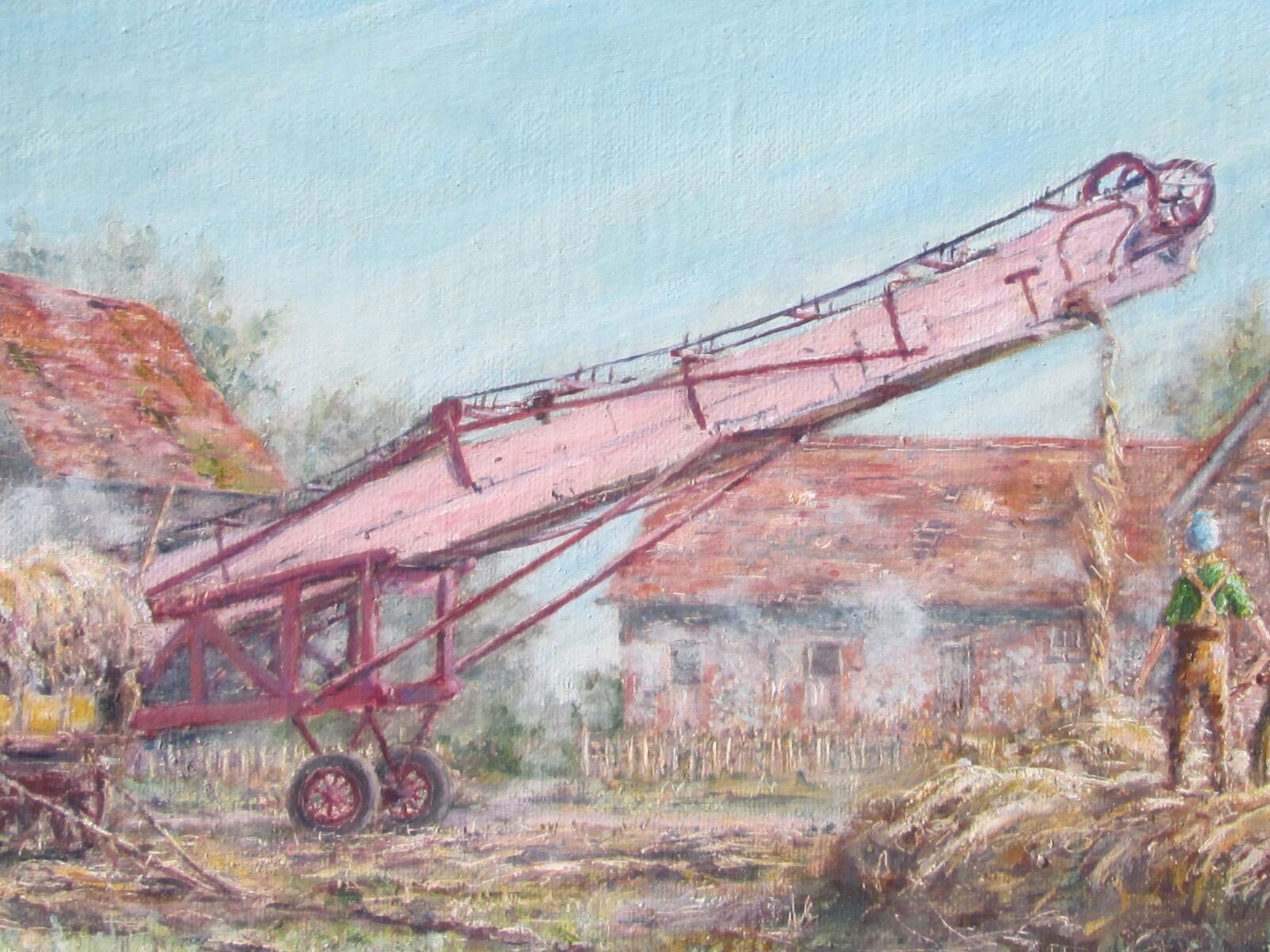
Details, details.. but such things are not just there as ‘set dressing’, they speak volumes of the nature of a place and the people of that place; a proudly settled people, of a defiant island nation, whose last experience of the turmoil of invasion lay nearly nine centuries in the past.
The machinery of the farm that ties the painting together has its own contribution to the story to tell. It speaks in different words and of different things to the old farm buildings, but the glorious technical details of each farm artefact here are rich in their own history of place and time too.
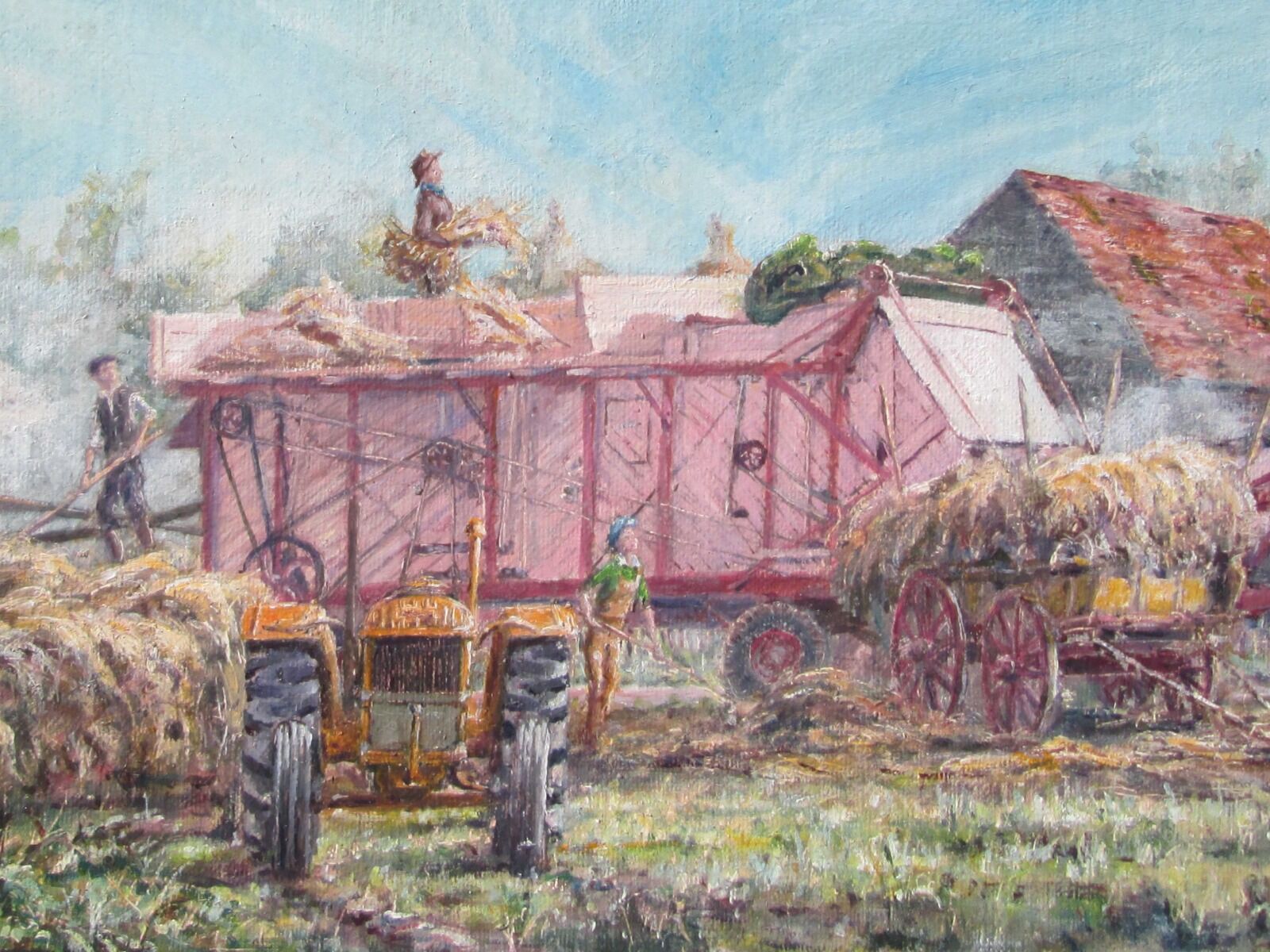
The deep whirring hum of the threshing machine and straw elevator powered by steam traction engine represent the last real decade of earnest use of technologies rooted in the Industrial Revolution. Their presence here though, tells of how the service of such machines was extended at the time by the difficulty of sparing resources for new farm machinery, given the pressing material and manufacturing needs for cutting edge military technology, just like those Spitfires passing overhead.
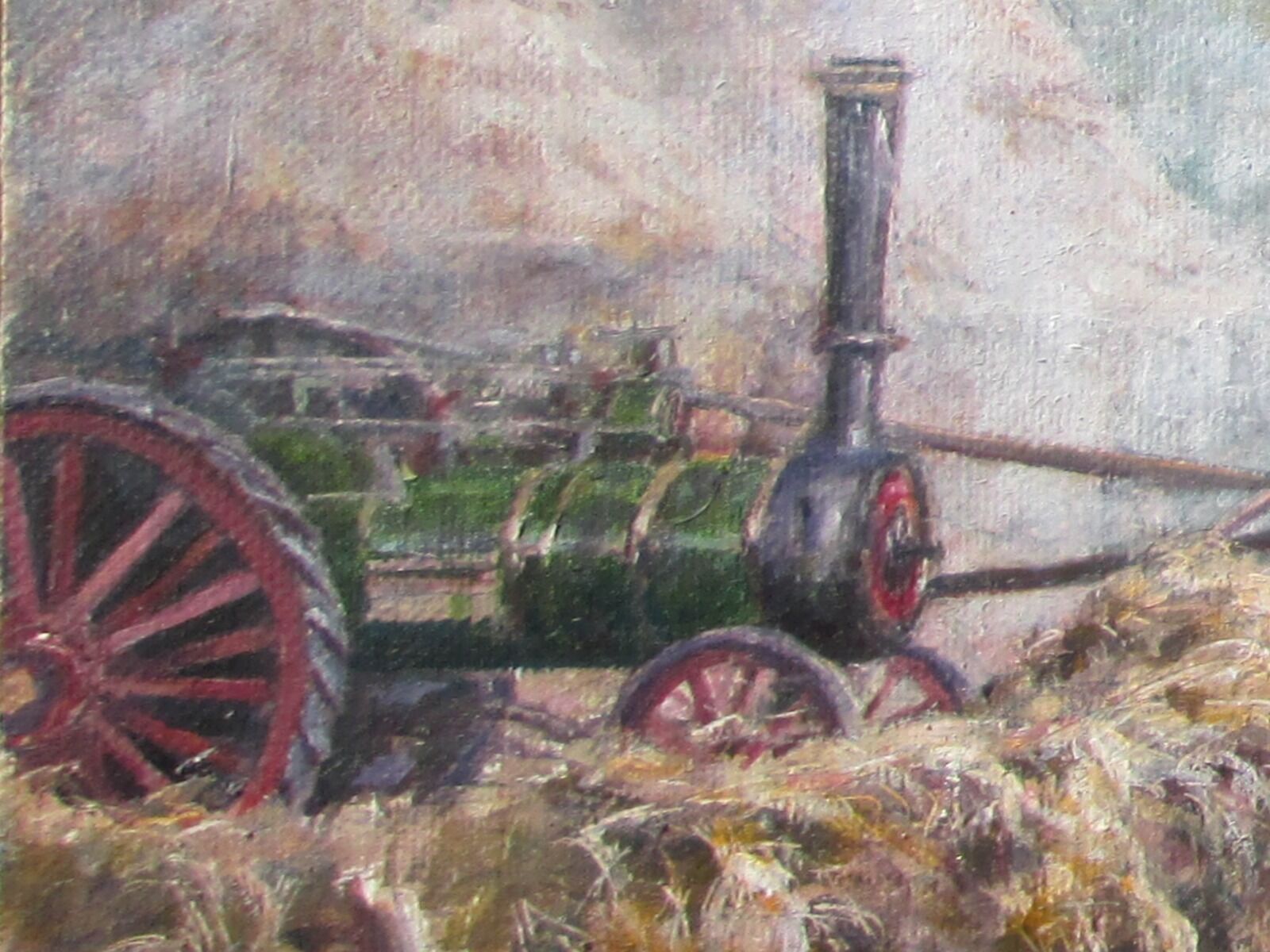
Pressed even further in to the closing days of its functional worth here is the old Kentish waggon, technology that stretches back at least a hundred years prior to the main threshing set here. It brings an almost incongruous echo to the scene, speaking as it does of the quieter, slower times of the past. Even it is not immune from change though. Its horse shafts have been removed and replaced with a tractor towing bar, and it seems to stand with a certain resigned acquiescence alongside the nearby tractor, the Fordson Model N.
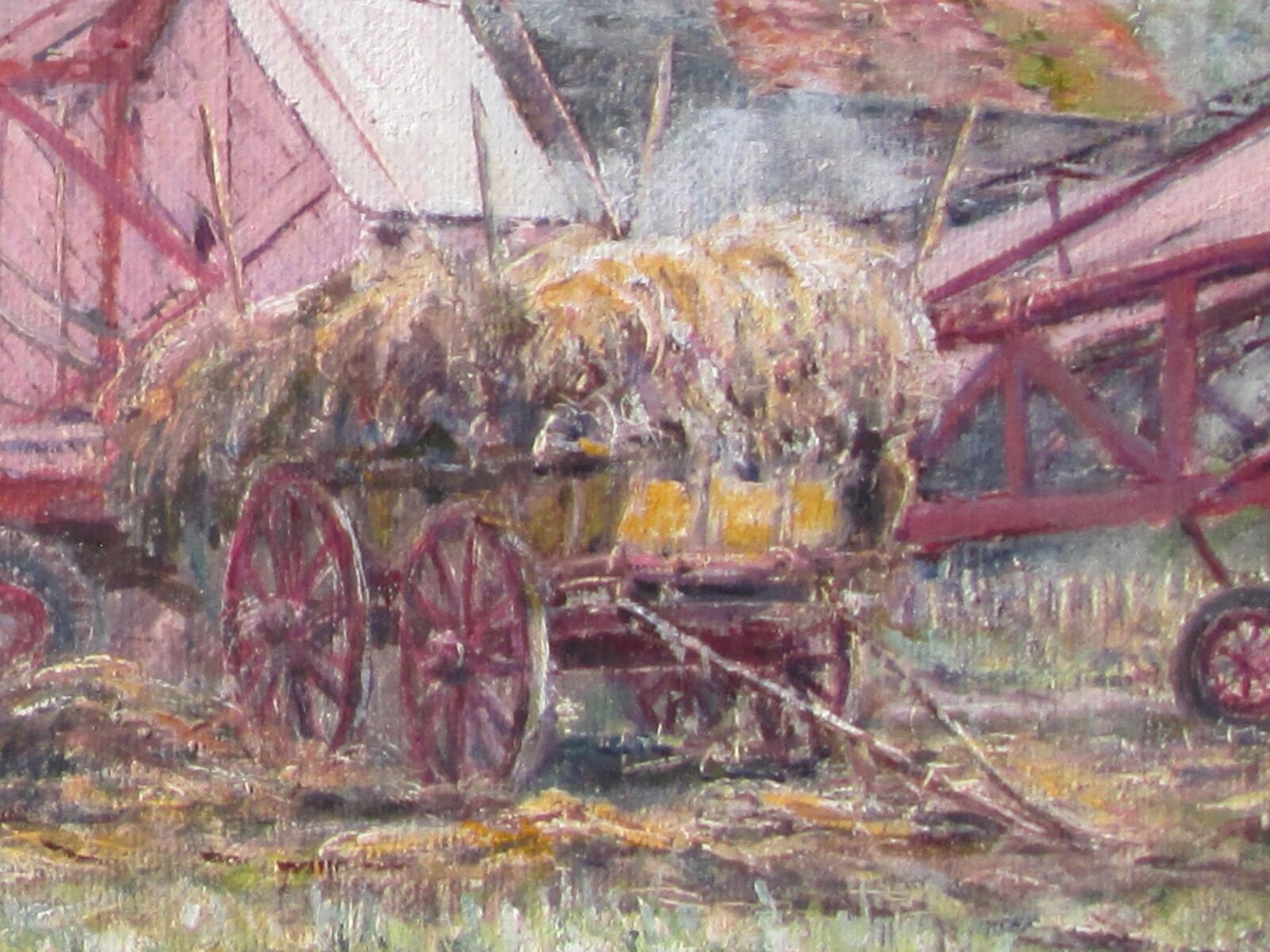
This tractor is probably the most modern piece of kit on view here, bar the Spitfires overhead, having appeared on British farms during the thirties. Looking at it now though, through the viewfinder of history, its presence here foreshadows the arrival of thousands of such tractors into Britain from America, under the Lend Lease Scheme, which was to come into place less than a year after the moment depicted. And this fact was no mere coincidence, as the thawing of American public opinion towards supporting the British in her war efforts were undoubtedly swayed by the immense resilience shown by the British people in scenes such as this during the Battle of Britain.
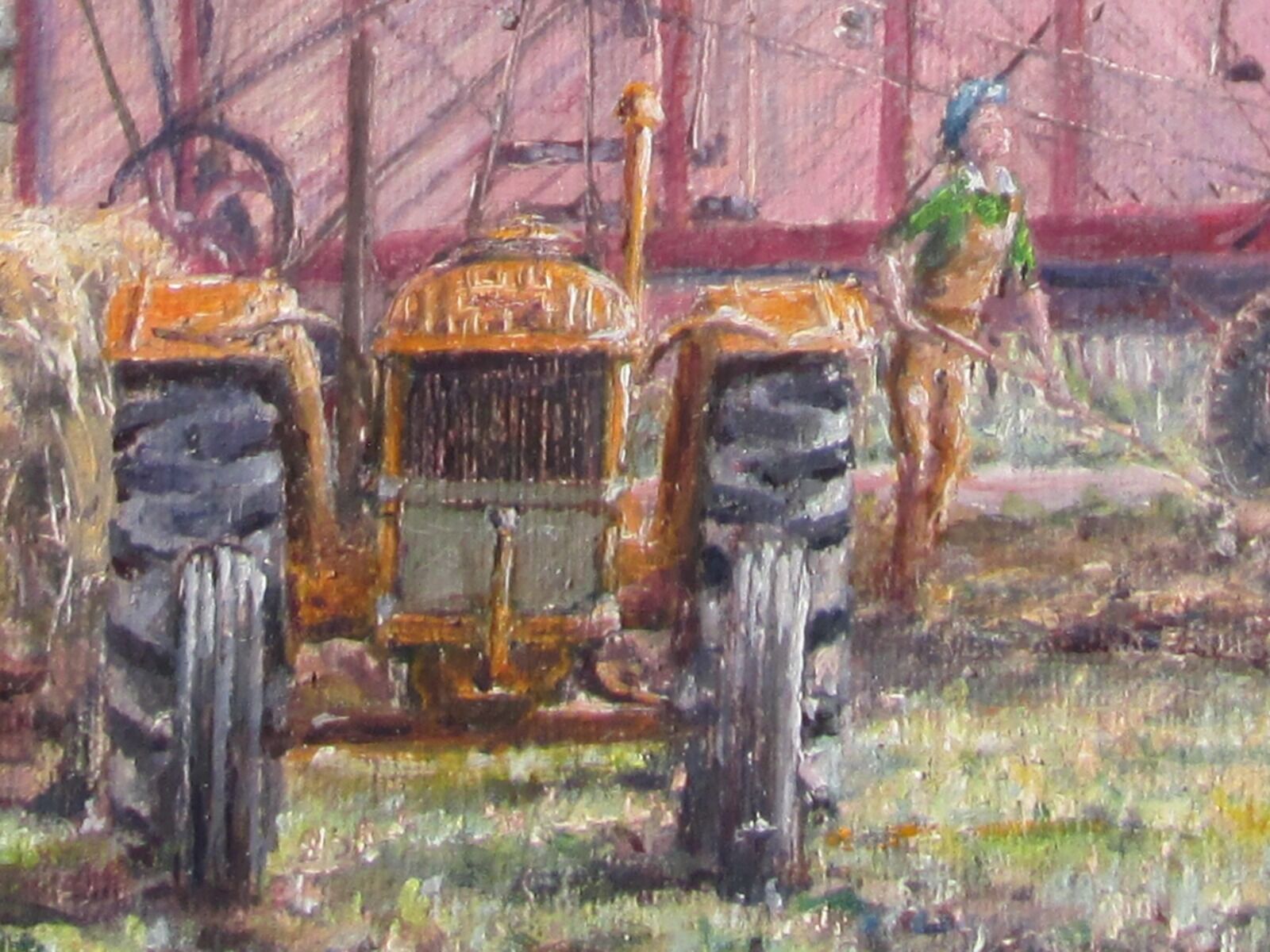
And the meaning of all the detail in the piece doesn’t end with the farm machinery. The threshing scene which I had envisioned seemed perfect not only for the time of year, but also to bring together in one spot a whole miscellany of the ‘people of the land’. To me, this not only showed their commonality of endeavour, but also reflected the range of threads of so many individual lives whose stories would likely cross and re-cross as threads in the tapestry of the war that lay ahead…
So, even though at the size they are in the painting, each face is slightly indistinct, perhaps like the blur of our memories with time; each figure in the painting represents a story of their own and sets the mind to wondering about their joint and several fates:
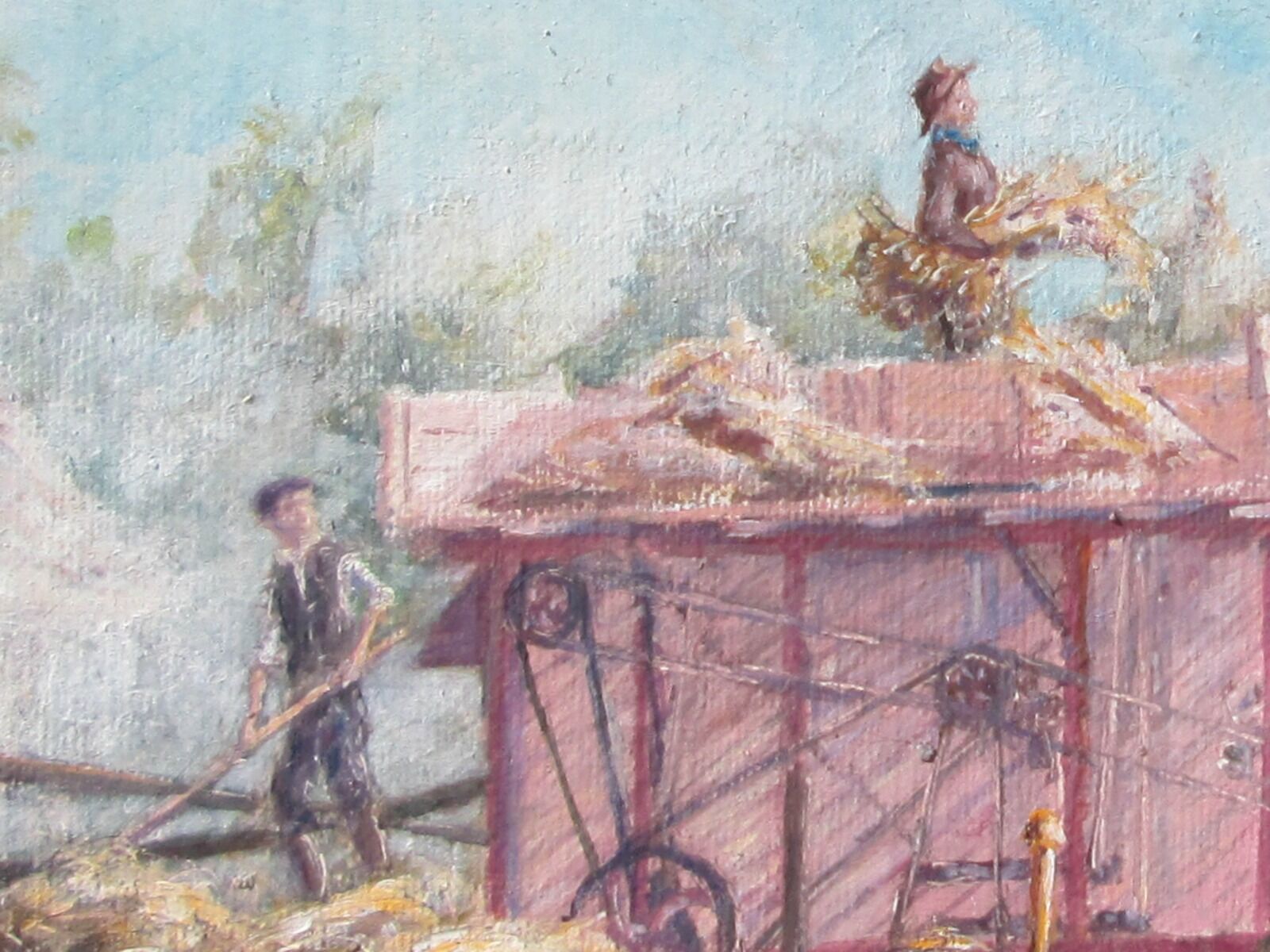
One at least amongst them will be a figure such as Robert Bailey, likely a tenant farmer, with all the attendant weight of responsibility of such a life on his shoulders. Perhaps there’s an older guy in amongst them too, old enough to remember ‘the last time around’, the First World War, weighing up the madness of seeing this all come to pass again, against the deeply perceived necessity of the situation.
What of the younger lads in the picture? Do they look skyward and see dreams of themselves in those cockpits above, seeing only the eagle like soaring of the aircraft above, mixed with the glamour of the smart young pilots who seem to draw all the attention down at the local? Perhaps instead, they quietly await their own call up papers, with a mix of excitement and fear in equal measure, knowing they will be pulled from the only life they’ve ever known, to who knows what end.
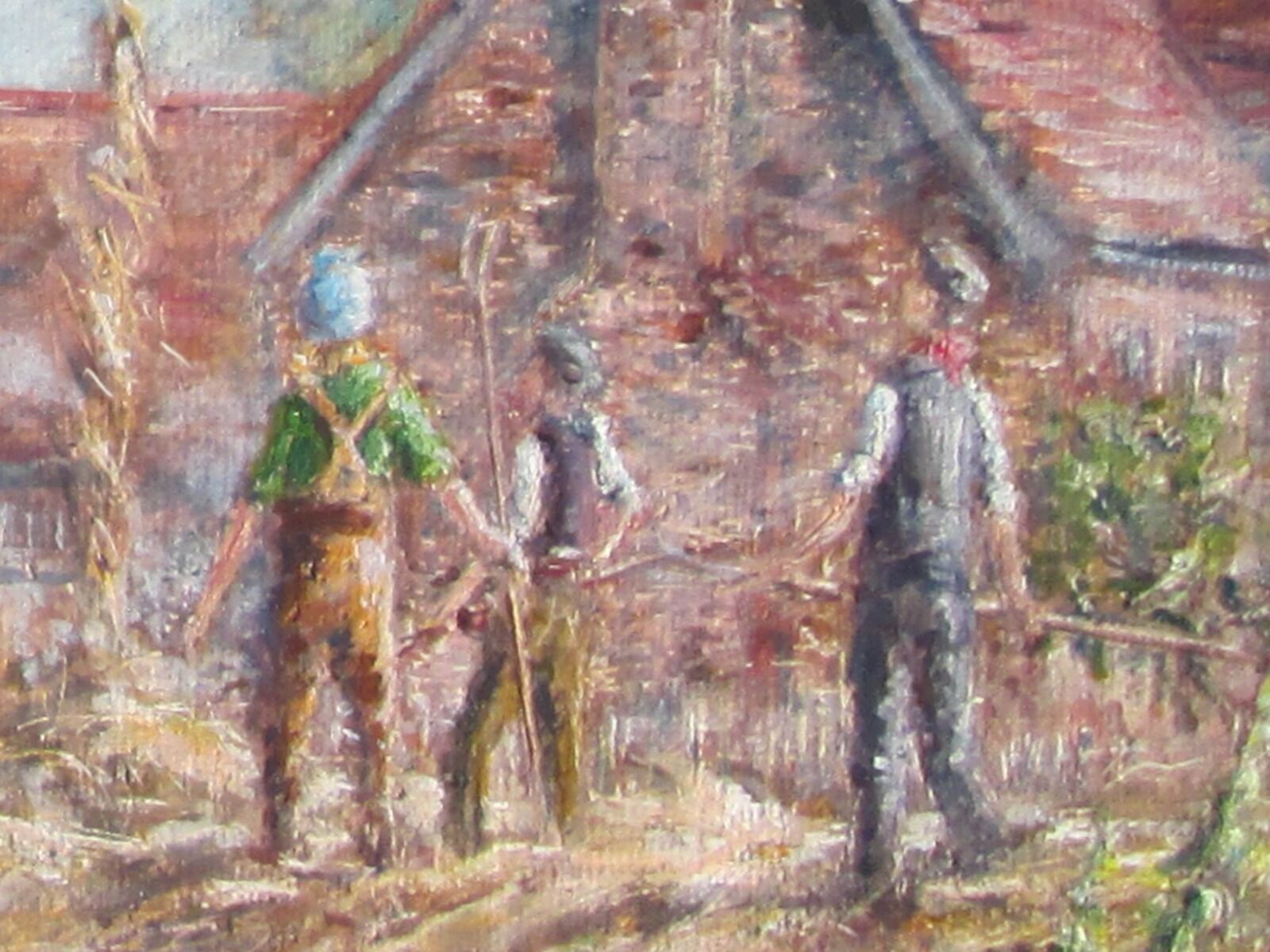
And as the eye scans across the assembled working party here, all frozen in their work as their faces briefly turn skyward at the compelling roar of the Merlins overhead, one can’t fail to notice the ‘Land Girls’. Shouldering their own changes of life for the war effort, by simply facing the challenges of this tough new job in an unfamiliar environment, would have been enough on its own. But here they are, working hard in their assigned tasks, yet only a stone’s throw from a frontline fighter airfield in one direction and with the anti-invasion-obstacle lined shore barely further in the other…who can imagine what thoughts must have run through their heads daily?
As we follow the upturned eyes towards those Spitfires, there are clearly more stories to tell in the lives of the pilots, whose stories I have told in another article:Article on the 610 Squadron Pilots in the painting Having read an entire book over the time that I created the piece, on the actions of 610 Squadron during the summer of 1940, my mind was left reeling with the multitude of life stories that the painting felt to represent.
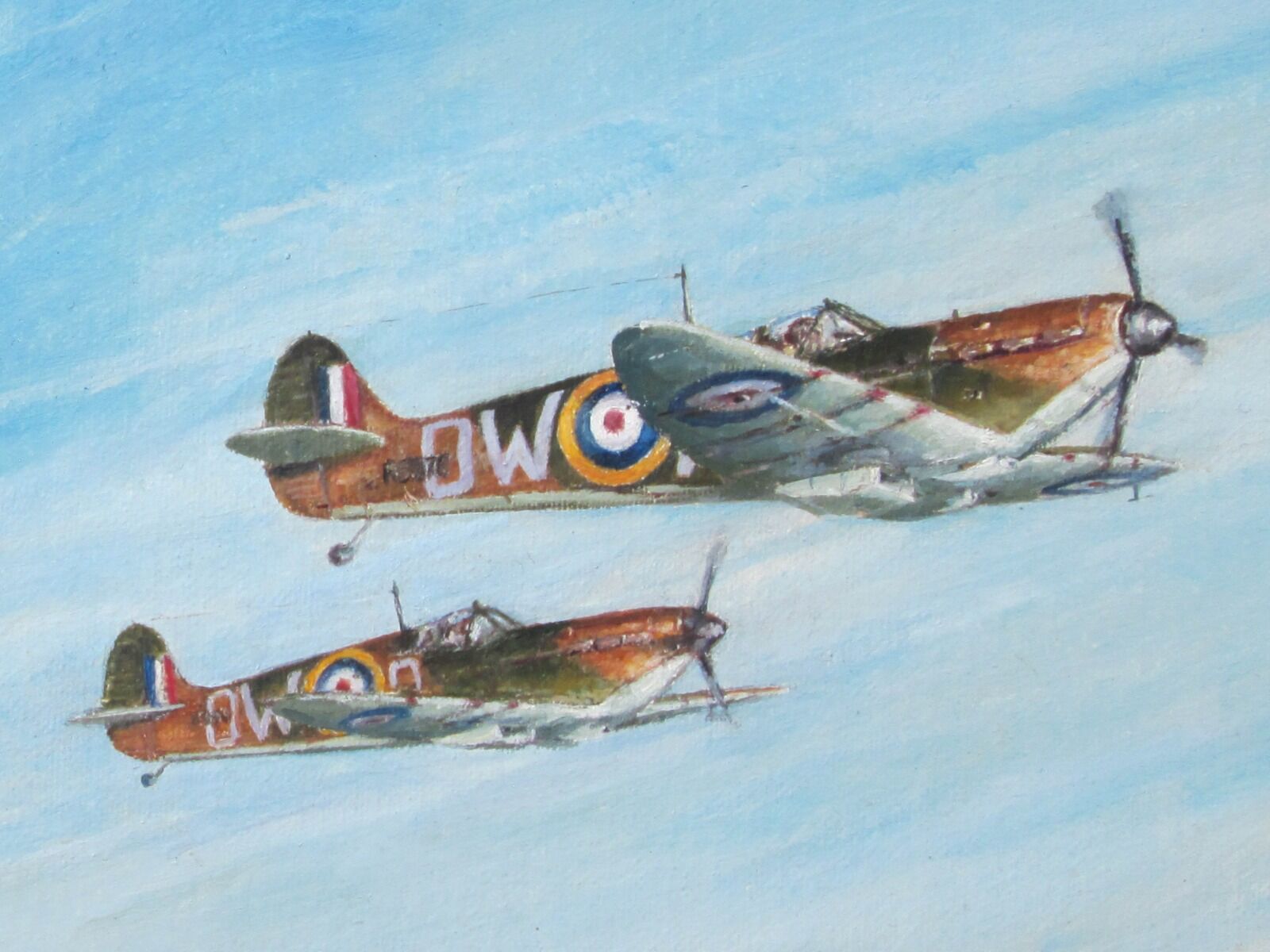
I don’t think that it’s any wonder that in attempting to create a tribute to this generation to whom we owe so much that I should become so wholly absorbed in the details of their world. Each lingering brushstroke yearns to try and tell their story in the best way that I know how. Its intent may be commemorative, but the stories that lie behind it sum to a tale of utmost resilience in the face of almost overwhelming odds, and are deeply inspirational even after the passing of all this time.
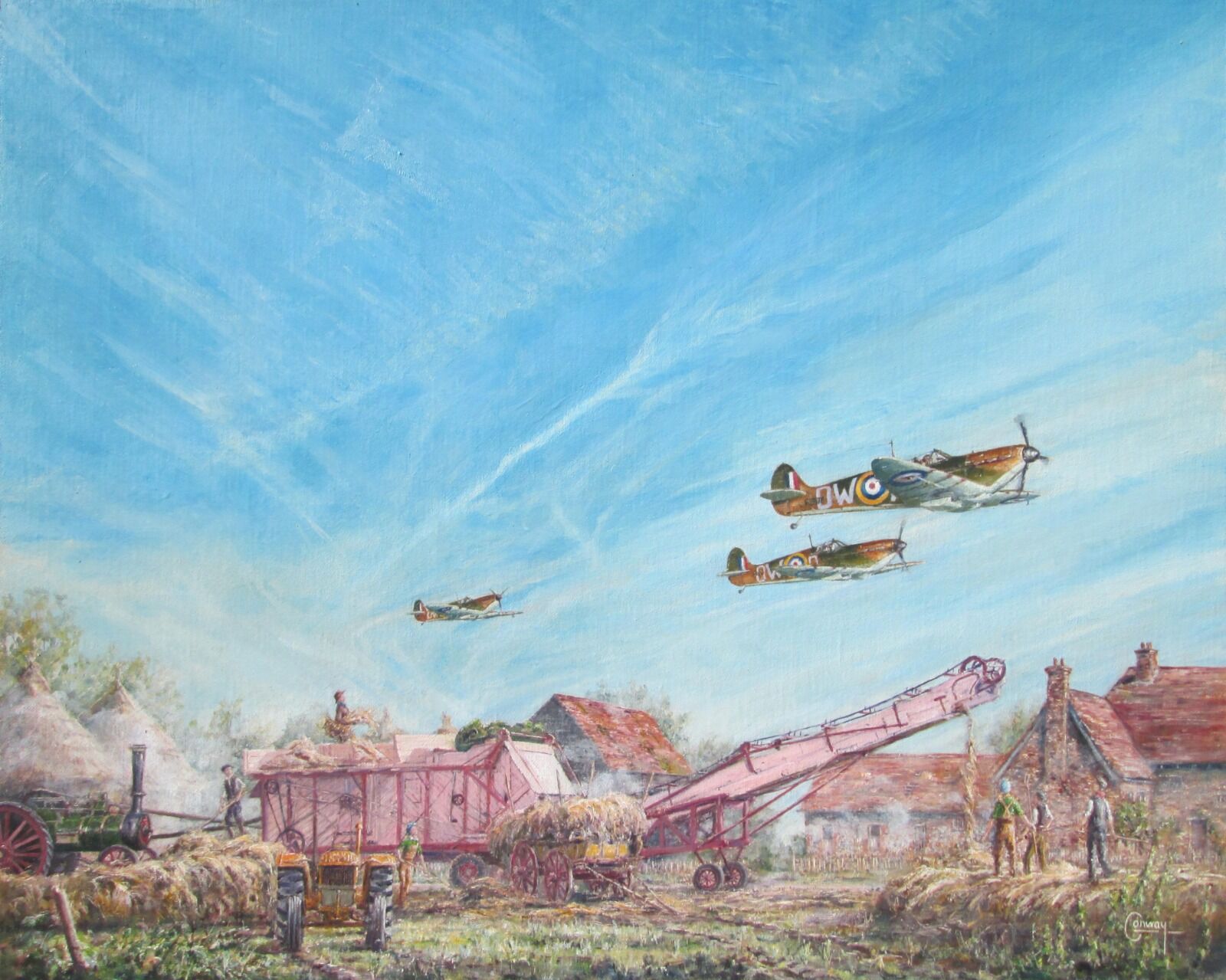
On the face of it, it’s an ‘aviation painting’, and so in that regard, many might have felt that a briefer treatment of the scene on the ground would have been entirely adequate to ‘set the scene’ of the action overhead.
But what if the genesis of the painting was in fact there amidst all that ‘scene setting’ farming activity? Even almost lost in the background of it? Because that is where the story of this painting actually started for me… in that rather ancient looking old clay brick and tile farmhouse, and even though that was the original ‘anchor’ for the piece… it’s not a real farmhouse either… perhaps I’d better explain!
It was the excellent book, ‘Eagle Day’, by Richard Collier, that set this all in motion. His account of a small part of the Battle of Britain weaves together stories from both sides of the conflict with stories from civilians living around and amongst it too, on both sides of the Channel. In doing so, he creates a startling picture of this brief, but oh so significant, moment in historical time, and thereby throws one’s sensibility to the moment into something of the perspective of those that lived through it.
Whilst many of us today still appreciate the importance of the Battle in determining the eventual outcome of the war, those that lived at the moment coped not only with the trials imposed by its happening, but also with a deep sense of ‘not knowing’ about how things would turn out... something like the ‘what ifs’ of our everyday lives, magnified a thousand time in significance perhaps.
Nowhere did the sense of this strike me more than in one of the tales woven through the book; a tale following the fate of a 40 year old farmer and family man, Robert Bailey. His farm, ‘Ladwood Farm’, stood within two miles of RAF Hawkinge in Kent, and only a few miles from the coast.
Not only was the nearby presence of one of the frontline Fighter Command airfields something that suddenly had a whole new significance for him, but there was also the fact of being only a few miles from the Kent coast, which carried the very real risk of being full of German soldiers any day soon.
It is not for me to retell Bailey’s story here, but in reading it, we live through his decision to stay put and keep farming, whilst many in the local area moved away in the face of the immense perceived risk. This is swiftly followed by the need to divert activity from the pressing daily needs of the farm to dig a decent air raid shelter for the family. Perhaps the most striking moment for me, was living vicariously through his witnessing a Hurricane pilot baling out, then watching as the abandoned stricken aircraft soared mindlessly towards the farmhouse occupied at that moment by the whole of his family, only for it to veer away in a slight quiver of wind, the relief of this heavily tempered by its new ‘aim’ being directly at his entire herd of cattle all huddled up together in a field corner…
It is only right to share here that the incident ended relatively benignly, the Hurricane clipping a tree branch at the last moment and swerving into the farm’s woodland, but the fear in the moment was palpable and real.
It was reading of this incident especially that set this painting in motion for me, for it brought home just how closely the fates of those living and working under the battle woven skies in South East England in 1940 were bound up with their compatriots in the air. Not only was the vital food they were producing key to the country’s survival, but the drama of the combat played out above them was highly tangible and, even if not to the same extent as faced by those airmen above, risks to life and limb were ever present too.
As it was this story of Bailey’s that had brought the idea of the painting into being, my first thought had been to try and paint a scene with Ladwood Farm, or one of the other specific farms close to Hawkinge. The idea being to tie together in the painting the interlinked nature of the life on the ground and in the air at this strange moment in time. After some research, I decided that the idea of trying to show a specific farm there as it was in 1940 would take an unfeasible level of research to portray honestly.
It was in the scope of the same set of thoughts though, that I realised that perhaps the abstraction of painting a fictionalised farm which could in many ways represent Bailey’s experience and others whose experiences must have been similar, would be entirely appropriate. As a painting direction to go in, it seemed a good one, given my interest in vernacular farm buildings and fascination with, and involvement in, historical farm practices. This would allow me a lot more freedom of composition to express the core idea of the painting.
And so the quaint little farm of the painting was born, with its long interesting roofs, bold chimneys and funny mix of curious sized little leaded windows. Adjoined to this is a small entourage of farm buildings added to it over the previous hundred or so years, together with one of those notable signs of the wilting fortunes of 1930s depression era farming, the hole ridden roofs.

Details, details.. but such things are not just there as ‘set dressing’, they speak volumes of the nature of a place and the people of that place; a proudly settled people, of a defiant island nation, whose last experience of the turmoil of invasion lay nearly nine centuries in the past.
The machinery of the farm that ties the painting together has its own contribution to the story to tell. It speaks in different words and of different things to the old farm buildings, but the glorious technical details of each farm artefact here are rich in their own history of place and time too.

The deep whirring hum of the threshing machine and straw elevator powered by steam traction engine represent the last real decade of earnest use of technologies rooted in the Industrial Revolution. Their presence here though, tells of how the service of such machines was extended at the time by the difficulty of sparing resources for new farm machinery, given the pressing material and manufacturing needs for cutting edge military technology, just like those Spitfires passing overhead.

Pressed even further in to the closing days of its functional worth here is the old Kentish waggon, technology that stretches back at least a hundred years prior to the main threshing set here. It brings an almost incongruous echo to the scene, speaking as it does of the quieter, slower times of the past. Even it is not immune from change though. Its horse shafts have been removed and replaced with a tractor towing bar, and it seems to stand with a certain resigned acquiescence alongside the nearby tractor, the Fordson Model N.

This tractor is probably the most modern piece of kit on view here, bar the Spitfires overhead, having appeared on British farms during the thirties. Looking at it now though, through the viewfinder of history, its presence here foreshadows the arrival of thousands of such tractors into Britain from America, under the Lend Lease Scheme, which was to come into place less than a year after the moment depicted. And this fact was no mere coincidence, as the thawing of American public opinion towards supporting the British in her war efforts were undoubtedly swayed by the immense resilience shown by the British people in scenes such as this during the Battle of Britain.

And the meaning of all the detail in the piece doesn’t end with the farm machinery. The threshing scene which I had envisioned seemed perfect not only for the time of year, but also to bring together in one spot a whole miscellany of the ‘people of the land’. To me, this not only showed their commonality of endeavour, but also reflected the range of threads of so many individual lives whose stories would likely cross and re-cross as threads in the tapestry of the war that lay ahead…
So, even though at the size they are in the painting, each face is slightly indistinct, perhaps like the blur of our memories with time; each figure in the painting represents a story of their own and sets the mind to wondering about their joint and several fates:

One at least amongst them will be a figure such as Robert Bailey, likely a tenant farmer, with all the attendant weight of responsibility of such a life on his shoulders. Perhaps there’s an older guy in amongst them too, old enough to remember ‘the last time around’, the First World War, weighing up the madness of seeing this all come to pass again, against the deeply perceived necessity of the situation.
What of the younger lads in the picture? Do they look skyward and see dreams of themselves in those cockpits above, seeing only the eagle like soaring of the aircraft above, mixed with the glamour of the smart young pilots who seem to draw all the attention down at the local? Perhaps instead, they quietly await their own call up papers, with a mix of excitement and fear in equal measure, knowing they will be pulled from the only life they’ve ever known, to who knows what end.

And as the eye scans across the assembled working party here, all frozen in their work as their faces briefly turn skyward at the compelling roar of the Merlins overhead, one can’t fail to notice the ‘Land Girls’. Shouldering their own changes of life for the war effort, by simply facing the challenges of this tough new job in an unfamiliar environment, would have been enough on its own. But here they are, working hard in their assigned tasks, yet only a stone’s throw from a frontline fighter airfield in one direction and with the anti-invasion-obstacle lined shore barely further in the other…who can imagine what thoughts must have run through their heads daily?
As we follow the upturned eyes towards those Spitfires, there are clearly more stories to tell in the lives of the pilots, whose stories I have told in another article:Article on the 610 Squadron Pilots in the painting Having read an entire book over the time that I created the piece, on the actions of 610 Squadron during the summer of 1940, my mind was left reeling with the multitude of life stories that the painting felt to represent.

I don’t think that it’s any wonder that in attempting to create a tribute to this generation to whom we owe so much that I should become so wholly absorbed in the details of their world. Each lingering brushstroke yearns to try and tell their story in the best way that I know how. Its intent may be commemorative, but the stories that lie behind it sum to a tale of utmost resilience in the face of almost overwhelming odds, and are deeply inspirational even after the passing of all this time.

